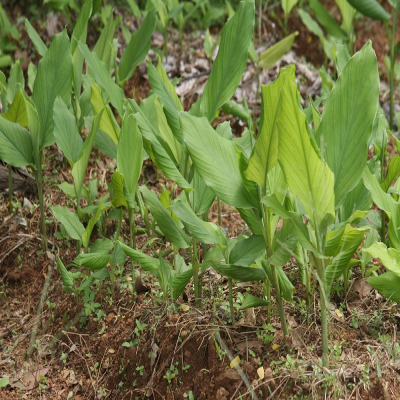Distribution and Habitat: Wild turmeric is found wild throughout India and it is distributed in South East Asia. The plant grows wild in the eastern Himalayas and in moist deciduous forests of Kerala and Karnataka.
Botany: It is a perennial rhizomatous herb with annulate, aromatic, cream coloured rhizome which is internally orange-red in colour.
- Leaves: Elliptic or lanceolate-oblong, caudate-acuminate, 30-60cm long, petioles as long or even longer, bracts ovate, recurved, more or less tinged with red or pink.
- Flowers: Pink, lip yellow, obovate, deflexed and sub-entire or obscurely three lobed.
- Fruits: Dehiscent, globose, 3-valved capsules.
Properties: Spasmolytic, carminative, stimulant.
Chemical constituents: Essential oil contains a-and -b-curcumene, d-camphene and p-methoxy cinnamic acid. The colouring matter is curcumin. Numerous sesquiterpenoids of germacrone and guaiane skeletons have been identified recently. Rhizome has effect on respiration. It is spasmolytic and shows antagonism of amphetamine hyperactivity. Rhizome is an anti-dote for snakebite and carminative.
Uses: Rhizome of wild turmeric is used in combination with astringents and aromatics for bruises, sprains and hiccough, bronchitis, cough, leucoderma and skin eruptions. It is used for the cure of chronic skin diseases caused by impure blood. It is used as appetiser and tonic for women after childbirth. It is also useful against high fever and worm infestation. The rhizome is an odoriferous ingredient of the cosmetics.
Formulations: Bratia tyadi kwatha
Agrotechnology
Climate and soil: In India it is cultivated in Bengal and Kerala. It is grown as a subsistence crop in backyard, kitchen garden and interspaces of other crops in areas with good rainfall. Well-drained rich loamy soils are ideal for the drop.
Propagation: It is largely raised as a rain fed crop during May- June with the pre-monsoon showers. It is propagated vegetatively by rhizomes and by tissue culture methods. Clear the area, remove all the pebbles and stones and plough the field to good tilth. Incorporate FYM/organic manure at 10-15t/ha. Prepare raised seedbeds of 1.2m breadth and convenient length. Healthy disease free mother rhizomes with at least one germinated sprout is the planting material, which is required at 1500kg/ha. Take small pits at 60X40 cm spacing on the seedbed and plant seed rhizome with the germinating sprout facing upwards. Cover the rhizome with FYM and mulch the bed with leaves or straw.
Varieties: At present, only local types are available for cultivation
Manuring: Apply fertilisers at 100:50:50 kg NPK/ha, entire P as basal and N and K in two equal splits at planting and two months after planting.
Aftercultivation: Carry out gap filling if necessary within one month. Remove weeds 2 months after planting followed by top dressing, earthing up and mulching.
Plant protection: No serious pest and diseases are encountered in the crop.
Harvesting: The crop matures in 7 months. Drying up of leaves is the indication of maturity. Dig out the rhizomes without causing damage. Remove the dry leaves and roots. The clean rhizomes are either marketed or dried and stored. The average yield of fresh rhizome is 28t/ha which on drying gives 27% recovery.
Processing: The rhizome is thinly sliced and steam distilled for 3-4 hours for extracting the essential oil and the yield is 90l/ha. Oil recovery is 0.33 % on fresh weight basis and 1.05 % on dry weight basis.

